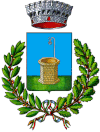Pianoro
| Pianoro | ||
|---|---|---|

|
|
|
| Country | Italy | |
| region | Emilia-Romagna | |
| Metropolitan city | Bologna (BO) | |
| Local name | Pianôr | |
| Coordinates | 44 ° 23 ' N , 11 ° 20' E | |
| height | 200 m slm | |
| surface | 107 km² | |
| Residents | 17,625 (Dec. 31, 2019) | |
| Population density | 165 inhabitants / km² | |
| Post Code | 40065 | |
| prefix | 051 | |
| ISTAT number | 037047 | |
| Popular name | Pianoresi | |
| Patron saint | Mary of Nazareth | |
| Website | Pianoro | |
Pianoro is an Italian commune with 17,625 inhabitants (as of December 31, 2019) in the metropolitan city of Bologna in the Emilia-Romagna region . It is located in the valley of the Savena River , between the old Roman road and the historic road to the Futapass , 13 km south of Bologna . The name of the community comes from Latin ( planurium "plateau"). Strada Statale 65 runs through the town between Bologna and Florence . The community is a member and seat of the Comunità Montana Cinque Valli Bolognesi .
Neighboring municipalities are Bologna , Loiano , Monterenzio , Monzuno , Ozzano dell'Emilia , San Lazzaro di Savena , Sasso Marconi .
history
The emergence of the region can be traced back to the subjugation of numerous communities that were independent up to that time and were restructured as a result of Napoleonic measures of that time. The only center in the area of these changes was the parish. Livergnano came under Monzuno at the time of the division into the vicariates (1395) , while the other parishes of the Pianoro area fell under the rule of Bologna . At that time there were two middle strips of land between the city and the region: the "Guardia", namely the parishes that existed outside the city walls, but were under the administration of the city church of San Pietro, the strip of the suburbio , the strip of the Municipal government was dependent and then came the actual landscape (= Contea ). That is why the history of the municipality of Pianoro cannot be exactly understood if one looks at the area in its current structure. After the 12th century, with the annexation to the municipality, the history of the individual municipalities was associated with that of the municipality of Bologna.
Before that time we only have fragmentary reports: in 1034 Boniface of Canossa acquired parts of the area. Afterwards his daughter, Mathilde von Canossa , gave it to the church of Pisa . Various families of applicants followed one after the other: the Albertis of Prato , the Panicos , the Loianis , etc. In 1220 the municipality of Bologna confiscated the castle of Pianoro, which was the property of Count Albertis. The castle was probably not founded before the year 1000. The castle must not be confused with the much older castle of the same name near Zola Predosa . The castle we are referring to was perched on a mountaintop on the right side of the Savenas and served as a defense and protection for the communication artery that runs on its feet.
In 1377 the castle was built by the Bolognese destroyed because the Pianoreser an insurgent group against the government of the Papal States had supported and freedom from Bologna. Of all the buildings that were in the municipality, only a well and an inn for travelers remained. The survivors had to build a new village, which is now called Pianoro Vecchia and which was partially bombed in the Second World War . Another dangerous event for the piano lovers occurred in 1735, when a Spanish army passed through , playing arrogance and violence as masters and against which the people tried to rise up. In order to calm the destructive anger of the Spanish colonel, Cardinal Lambertini (later better known as Pope Benedict XIV ) had to intervene .
Looking at the historical events that shaped the area, it can be said that Pianoro was dependent on the road that crossed the Apennines . In the course of its history, the road had a similar course to today's state road to the Futapass. On the one hand, the road promoted the economy in the villages in Untertal, on the other hand, however, it made the community vulnerable and made them victims of many looting and destruction by armies passing through. Nevertheless, the piano players never surrendered to fate. In 1735 they rose against the Spanish troops; in 1869 they demonstrated against the meal tax and in 1911 they protested against the Italo -Turkish War . After all, during its most recent history, Pianoro was largely destroyed by World War II. The town hall was then rebuilt elsewhere: again on the road to the Futapass, but three kilometers further north. This is how Pianoro Nuova was created alongside Pianoro Vecchia.
Sons and daughters of the church
- Franco Grillini (* 1955), Italian politician, psychologist and journalist
Individual evidence
- ↑ Statistiche demografiche ISTAT. Monthly population statistics of the Istituto Nazionale di Statistica , as of December 31 of 2019.


